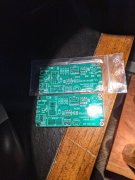I never liked how the factory wired these units with the power switch between the cord and fuse. Decided to do some testing and wired the primaries directly to the IEC socket. Found I got appx 10 dBFS less 60hz noise by wiring the striped primaries to the line and solid primaries to the neutral.
I then made red the line color, and green the neutral color.
Line runs from the IEC, to fuse tip and from base, to switch, then to striped primary. Green runs from IEC to switch, then to solid primary. The resistor and caps across the switch are removed for testing. I'll probaly replace the caps later, but not the resistor.

Here's result of testing outside. Thats with a 142 mV RMS 1kHz sine wave injected. Theoretically, the sound card base line #s gets subtracted from the unit being tested #s for final results. I'm going to do more work on the 60hz noise once I get the Quasimodo Test Jigs built.


I then made red the line color, and green the neutral color.
Line runs from the IEC, to fuse tip and from base, to switch, then to striped primary. Green runs from IEC to switch, then to solid primary. The resistor and caps across the switch are removed for testing. I'll probaly replace the caps later, but not the resistor.


Here's result of testing outside. Thats with a 142 mV RMS 1kHz sine wave injected. Theoretically, the sound card base line #s gets subtracted from the unit being tested #s for final results. I'm going to do more work on the 60hz noise once I get the Quasimodo Test Jigs built.


Last edited:


![IMG_4014[1].JPG IMG_4014[1].JPG](https://forums.phxaudiotape.com/data/attachments/50/50456-f6082c74b07166d63175c4e6286e0b39.jpg?hash=9ggsdLBxZt)






